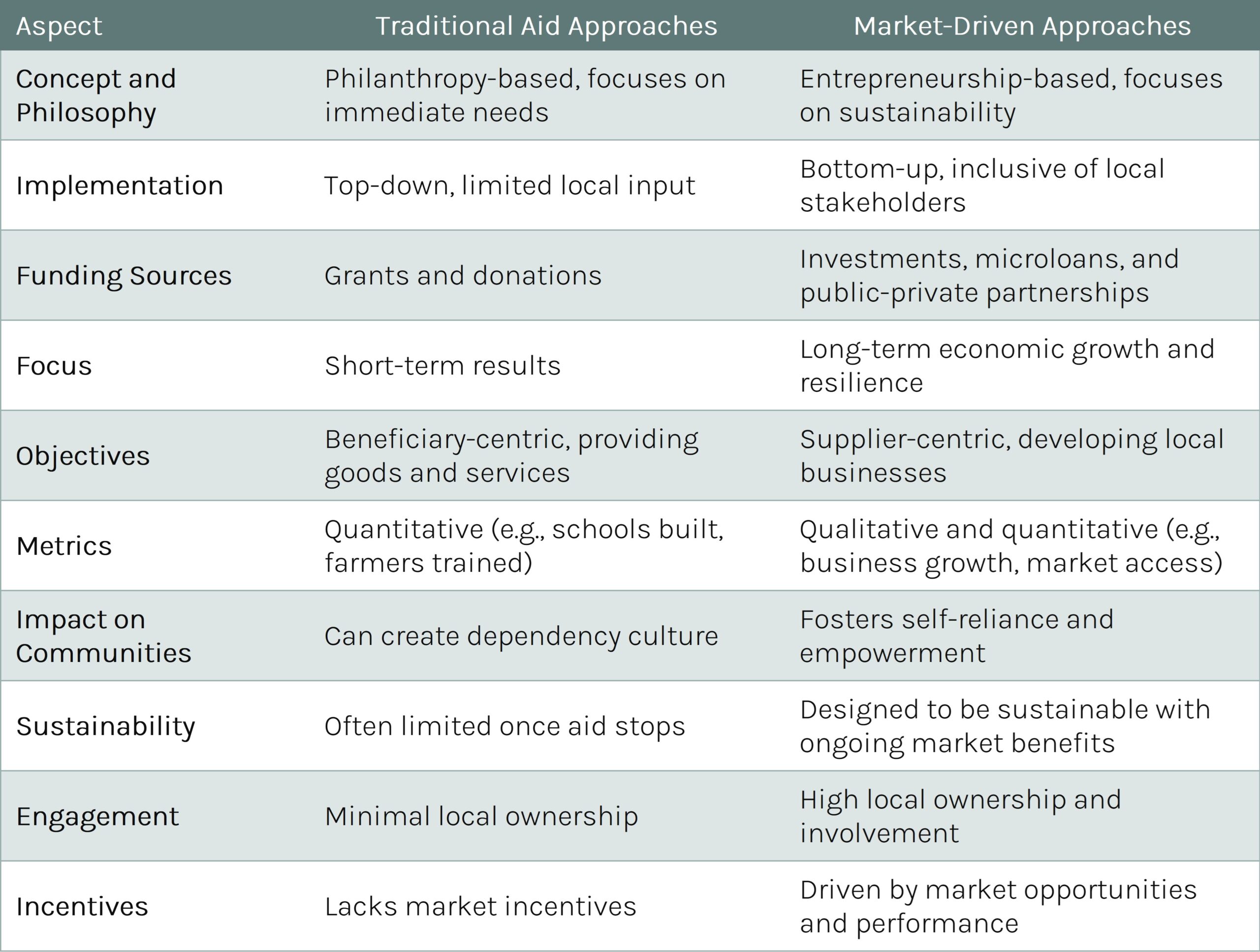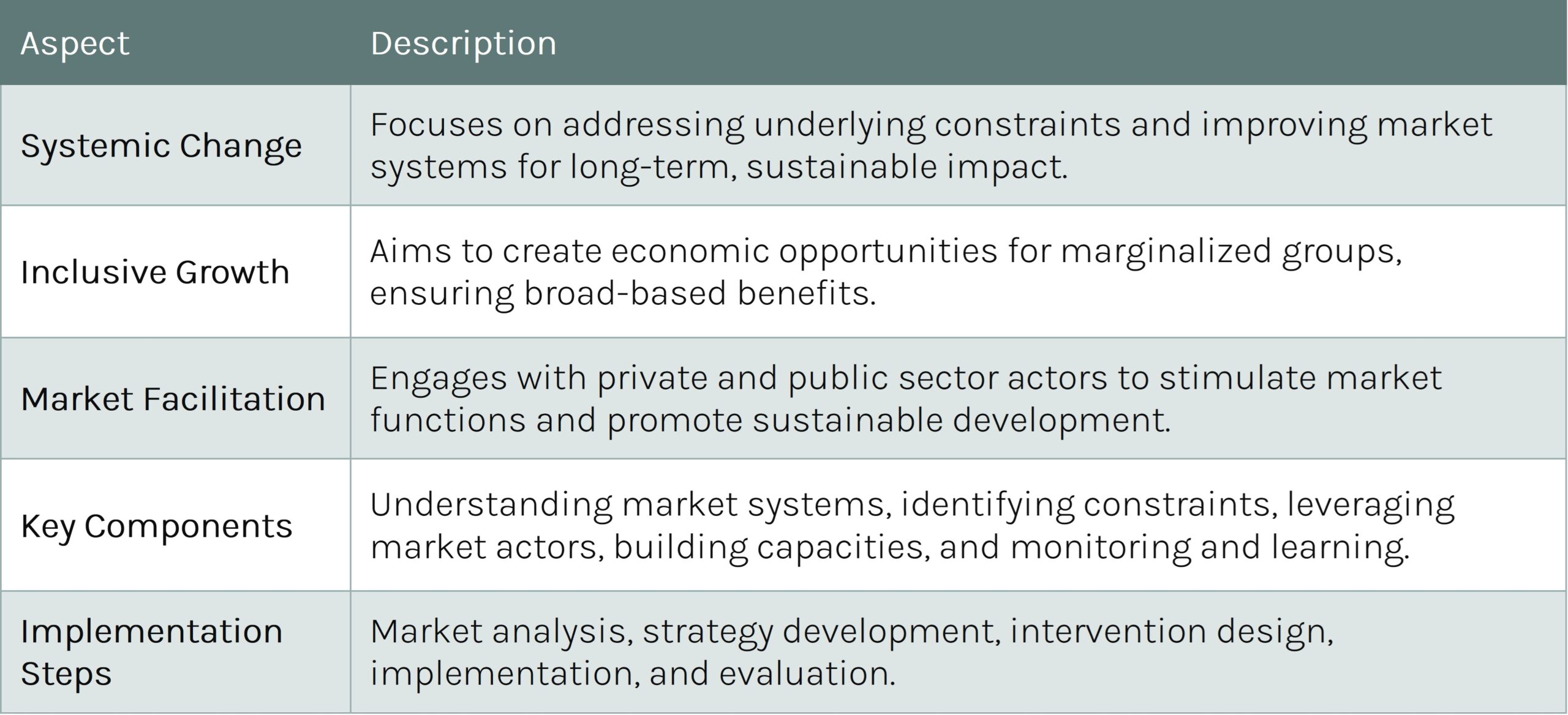- A story from Burkina Faso: The goat and the value chain
- Towards market-driven approaches
- A useful platform: Building Effective & Accessible Markets (BEAM)
- Conclusion on empowering smallholder farmers
Traditional aid approaches undermine entrepreneurial potential and create a dependency culture where farmers wait for the next handout rather than pursuing business growth potential. In this article we explore the transformative power of market-driven approaches, learn from real-life examples, and introduce some practical tools for long-term success. See the table below for a comparison on key aspects between traditional aid approaches and market-driven approaches.

A story from Burkina Faso: The goat and the value chain
The old man raised his voice as he addressed his fellow members of the cashew cooperative. His facial expression and body language made it clear that he was serious. He spoke with authority. I was sitting in a small warehouse in a village not far from the border between Burkina Faso and Mali, listening carefully to Souleymane, our agronomist and expert in managing relations with smallholder cooperatives. Souleymane accompanied me on all meetings with farmers and was translating Dioula to French for me in a hushed voice so as not to disturb the conversation that was going on.
About a hundred farmers were listening as the senior member of the cooperative spoke: “This is not a white man who has come to hand out gifts. This is business. So, if you do not repay your micro loan, I will personally come to collect your goat, sell it, and repay.” There was uneasy laughter in response to his contribution to the discussion which had been going on for almost two hours now. It was past noon, and it was getting hot inside the building, but we had reached a critical point in the town hall meeting.
The situation
It was 2015 and I had been in Burkina for less than half a year. The reason for meeting with the cooperative was that a year before, these farmers had received micro credits for the first time. These credits were disbursed for plantation maintenance (which they had been trained on) and were to be repaid once the cashew harvest came in. The idea was that through the credits farmers would realize higher crop yields and higher incomes. We were several months past harvest time and hardly a single farmer had paid off their credit. I had come to listen to these farmers and contribute to finding a way forward in the relationship.
At the beginning of the meeting, I had spoken about the loans, the intended outcomes and how it was expected to work. I explained that it was meant to create a win-win situation, with smallholder farmers generating higher income and the factory gaining access to higher volumes of good quality, traceable and certified nuts. I also mentioned that this had been a first experience but that the intention was to make this a returning service that farmers could expect for future years through their relationship with the factory. I also made it clear that our continued relationship was dependent on their full reimbursement of the loans.
The source of the problem
Sometime before the old man had spoken, another cashew farmer had shared his appreciation of the situation: he told me that although they understood the terms and conditions of the loan when they received the money a year earlier, that he didn’t expect anyone to come and collect twelve months down the line. Yes, read that again. When the farmers received the money, the generally accepted view in the cooperative of four hundred people was that this was a donor project and that even though it was called a loan, no actual performance or reimbursement was going to be enforced. The old man from the opening paragraph of this article drove home the realization that this was not free money but business.
After decades of development projects in Burkina Faso, these farmers had built a keen sense to identify what presented a business opportunity and when there were “gifts” or free money to be had from “white people”; whether they were treated as entrepreneurs or as “beneficiaries”. The many rusted project signs along the roads of Burkina Faso with logos from development organizations are an analogy to the stickiness of the results of these projects. From their perspective the farmers’ choices were probably a rational response to their experience with this sort of projects. I don’t blame them.
The cashew nut processing factory that we had come to lead in the few months prior to this meeting had learned a lesson: to make clear that the relationship between smallholder farmers and factory was not a donor-beneficiary relationship but a customer-supplier relationship. We were jointly working for clients with specific requirements in quality, traceability, impact and sustainability. This was simply business (with impact as a core driver) and the factory was offering an opportunity to cashew farmers and their cooperatives. Together we could develop an innovative value chain and bring development at the same time.

Thriving smallholder farmer cooperatives
Once that message was clarified and demonstrated through actions and not just words, the incentives were right: guaranteed markets, premium prices and technical assistance were only accessible through performance. Nothing else. Not just the performance of this cooperative improved, but of most the cooperatives that we were working with. Those that showed continued incapacity to respect contracts and engagements were eliminated as a supplier. As a result, most cooperatives that were serious thrived.
Getting the microloans right took us another year. We had learned another important lesson that day of the meeting in the rural area close to the Malian border: the power of the community. The old man was telling his neighbours that he would ensure the good standing of their cooperative by selling their goats if he had to. Social pressure from peers is much more effective than from outside people. Once we found a way to incorporate peer pressure into the micro loan system, we had no more reimbursement problems. Win-win for everyone.
Towards market-driven approaches
Increasingly, the pitfalls of the traditional aid approach are being recognized and more market-driven approaches have appeared where development actors (governments or NGO’s) partner with private sector to drive positive change. These usually take the form of public-private-partnerships (PPP’s).
But old habits die hard. If we want to realize impact, we need to stop talking about “beneficiaries” when working in PPPs. The “private” in PPP assumes that in one way or another we want market forces to contribute to the reaching of some sort of development goal. In fact, markets are to take centre stage in a PPP, otherwise it would be more effective to try and achieve the objectives through public or non-governmental ways. The concepts of “beneficiary” and “market” are mutually exclusive; in fact, in order to be successful in a PPP we need to drop the concept and word entirely.
A typical value chain development PPP case
Let’s take a typical case of value chain development where a private sector factory producing for export markets, is linked to local smallholder farmers. Some development goals could be to get the factory up to high standards (food safety, economies of scale or otherwise. Check our article on the challenges of processing in Africa to find out what sort of support would be appropriate) in order to unlock access to premium markets, so that both local factory workers and farmers supplying the factory benefit. For whatever reason the factory might not have the resources to realize this itself, and a development actor wants to contribute. At the same time, both the factory and the development agent see potential to increase farm efficiency and quality and so they launch a PPP focused on value chain development: farm improvements, cooperatives, farm-factory linkages and some developments on factory level.
The problem with “beneficiaries”
When public money is made available for the purpose as stated above it is quite typical for the PPP members to call the factory, cooperatives and smallholder farmers “beneficiaries”. Here is how that undermines the market forces that we’re looking to mobilize: beneficiaries are seen as the main objective of the PPP. In other words, the purpose of the PPP is perceived to be to hand over money and resources to the “beneficiaries” for their development. There is no market incentive present in this proposition. Moreover, the use of the word “beneficiary” creates a power dynamic where the “donor” holds the power and the “beneficiaries” are powerless.
Correct framing: market centred
To unleash the power of markets, the entire PPP must be framed from the private sector perspective: the donor(s) provide a “business opportunity”. Smallholder farmers are treated as suppliers and not as “beneficiaries”. The whole PPP must centre, in the case of this example, around the needs of the segment of the export market that has been chosen to produce/manufacture for. It is the market for the product that drives the PPP, not metrics such as farmers trained, equipment installed, or certifications achieved. These sorts of metrics are irrelevant if there is no market that is willing to pay for the output of the value chain. Moreover, treating actors within the PPP as suppliers instead of “beneficiaries” is empowering: you’re now engaging as business partners and as equals with obligations and responsibilities.
The business opportunity for both the farmer/cooperative and the factory needs to be clear: what are the specifications and other criteria that the product needs to meet in order to be successful? The PPP can bring to the table the tools to help the private sector actors meet the specifications, but it is up to the private sector actors to make the conscious choice to pursue this market and meet its requirements. And so, the PPP consortium needs to be ruthless in its annual decision-making process: farmers / cooperatives that show little interest or continued incapacity in meeting the market’s requirements need to be eliminated from the programme.
The tension between development KPI’s and business objectives
For the donor(s) in the PPP, the above might be anathema as it impacts their development KPI’s: in our experience, they’ve (often) committed to overly simple metrics such as smallholder farmers trained, and cooperatives developed instead of business outcomes. And yet, if the PPP consortium doesn’t do this, it is undermining its long-term success. The elimination process signals to all partners involved that meeting the requirements of the market is the key factor. If you don’t, you risk that the other farmers/cooperatives do no longer take the requirements seriously; you’re not providing them market incentives and you’re encouraging “beneficiary” behaviour.
The elimination process also allows to focus resources on the suppliers most ready and capable to seize the business opportunity that has been offered. This means indeed that the resources of the PPP go to the most entrepreneurial and not the poorest. Good! The PPP should be about value chain development. If its main objective was poverty alleviation some other structure such as direct cash transfers would have been more appropriate. Don’t get me wrong, PPPs have the potential to make substantial contributions to poverty alleviation but as a side effect of meeting markets expectations, not as the main objective.
The PPP paradox
In conclusion, public private partnerships need to be aware of the following paradox: in order to meet development goals, it’s best not to speak of them too much as it will undermine entrepreneurship and markets as the key driving forces that were meant to be mobilized through the PPP. The conception of PPP consortia, the project proposal, key metrics, etcetera need to be market oriented and business focussed. In well-designed PPPs, achieving the business outcomes will mean that the development objectives mill be met naturally as a side effect.
A useful platform: Building Effective & Accessible Markets (BEAM)
I have only just recently come across the BEAM Exchange and realized that without knowing it we’ve been using its approach and concepts. The platform does a great job in sharing knowledge about the successful use of markets in poverty reduction. It offers practical tools, case studies, and insights on using Market Systems Development (MSD) approaches to create lasting economic growth and reduce poverty. By emphasizing market-driven strategies, the BEAM Exchange helps businesses and development practitioners design more effective and sustainable projects.
What is the BEAM Exchange?
BEAM stands for “Building Effective and Accessible Markets.” This platform provides a wealth of resources to help you understand and implement MSD programs. The goal is to shift from traditional aid models to more market-oriented approaches that empower local businesses and communities, fostering sustainable development. The table below summarizes the key aspects of the advocated market systems development approach.

The top-3 features of MSD are the following:
- Systemic Change: MSD focuses on fixing the root causes of market problems. Instead of just treating symptoms, it changes the structures, rules, and relationships that shape market behavior, leading to more resilient and efficient market systems.
- Inclusive Growth: The approach ensures that economic benefits reach everyone, including marginalized and vulnerable groups. By promoting broad participation in the economy, MSD helps reduce inequality and improve livelihoods across the board.
- Market Facilitation: Rather than direct intervention, MSD facilitates and catalyzes changes within the market system. This means supporting local actors to take on roles and responsibilities that drive sustainable market development.
The MSD approach targets the underlying issues that prevent markets from functioning efficiently. It creates inclusive and sustainable economic opportunities by leveraging market forces and involving a wide range of stakeholders, including businesses, government agencies, and community organizations.
The Systems Approach to Value Chain Development
The systems approach to market development, emphasized by the BEAM Exchange, is key to creating lasting and scalable economic impact. This approach involves understanding and addressing the complex interactions within market systems. By tackling the root causes of market failures, it creates an environment where markets can function effectively and inclusively. Key benefits are:
- Sustainability: Systemic changes are more sustainable because they address the underlying causes of market dysfunction. This ensures that the benefits of interventions last long after initial support ends.
- Scalability: Transforming the market system allows the impacts of interventions to scale up and replicate across different contexts and sectors, leading to broader economic growth.
- Resilience: A well-functioning market system is more resilient to shocks and stresses. The systems approach builds the capacity of market actors to adapt and respond to changing conditions, ensuring long-term stability.
The BEAM Exchange outlines several key steps that define the market systems approach:
- Understanding Market Systems: A thorough analysis of market systems helps identify key constraints and opportunities. This involves mapping the various actors, relationships, and dynamics within the market.
- Identifying Constraints: Identifying the root causes of market failures helps design targeted interventions that address specific issues hindering market performance.
- Leveraging Market Actors: Engaging and collaborating with a diverse range of market actors, including businesses, government agencies, and community organizations, is essential. These actors drive systemic changes and ensure the sustainability of interventions.
- Building Capacities: Strengthening the abilities of local market actors through training, technical assistance, and access to resources enables them to perform effectively within the market system.
- Monitoring and Learning: Continuous monitoring and adaptive management are crucial. Regularly assessing the progress of interventions, learning from experiences, and making necessary adjustments help improve outcomes.
Overall, the steps and benefits make for a comprehensive market-driven approach.
Useful Case Studies of Market Systems Development
The BEAM Exchange provides numerous case studies demonstrating the effectiveness of the MSD approach. I’ve picked three that I found interesting.
ADVANCE II Project in Ghana
The ADVANCE II project enhanced the outgrower business model to improve scalability and sustainability. By linking smallholder farmers to markets, it increased productivity and income. The project provided technical assistance, market information, and access to finance, improving the agricultural value chain. The report goes into the changes that persisted three years after the close of the project. Interesting lessons!
LIWAY Program in Ethiopia
The LIWAY (Livelihoods Improvement for Women and Youth) program collaborated with public and private actors to address structural barriers and improve incomes for women and youth in Addis Ababa. By providing business development services, facilitating access to finance, and improving market linkages, participants saw significant income and opportunity improvements. The document includes a number of curated case studies.
Katalyst in Bangladesh
The Katalyst project aimed to improve the competitiveness of Bangladesh’s agriculture sector by fostering systemic changes in market systems. Working with private sector partners, it introduced new technologies, improved access to inputs, and enhanced market linkages. This led to increased productivity, higher incomes, and greater economic resilience for smallholder farmers. Katalyst is the best know project using the Market Systems Development approach.
How to Start Using the MSD Approach
Starting with the MSD approach involves several key steps:
- Market Analysis: Conduct a comprehensive analysis to understand the market systems, identify key actors, relationships, and dynamics, and pinpoint constraints hindering market performance.
- Strategy Development: Develop a strategy that addresses the identified constraints and leverages opportunities within the market system. This strategy should outline specific interventions and the roles of various stakeholders.
- Intervention Design: Design targeted and context-specific interventions focusing on facilitating systemic changes rather than direct provision of goods and services.
- Implementation: Collaborate closely with local market actors, providing them with the necessary support and resources to drive changes within the market system. Building their capacities is crucial for sustainability.
- Monitoring and Evaluation: Continuous monitoring and evaluation are essential to track progress, learn from experiences, and make necessary adjustments to interventions. Adaptive management ensures the project remains relevant and effective in a changing market environment.
As a word of caution, over the years we have been approached several times by development actors that “still needed a private sector partner” for the development of their PPP project proposal. As a business but also as a donor you need to steer clear from these. It is obvious that in these cases markets are an afterthought; the private sector is not in the driver’s seat. You’re not setting up for success but to simply checkbox the criteria for the calls for proposal.
For your PPP to succeed, the business needs to be in the driver’s seat and there must be clear business objectives to be achieved. The development targets linked to the business objectives must also be clear and mechanisms need to be in place to ensure that they materialize. Project adjustments must be possible and change of direction made if risks to their realization arise. Remember that the development agents’ main objective is contribution to the SDG’s, not your bottom line. From the donors you need alignment on the understanding of the importance of markets to deliver impact and the flexibility to adjust the project as and when markets change, as they often do. Alignment on business objectives and careful balancing of market and development targets are the key success factors for your next PPP.
Conclusion on empowering smallholder farmers
Empowering smallholder farmers through market-driven development is not just a theoretical concept; it’s a practical, proven strategy. Our journey in Burkina Faso and insights from platforms like the BEAM Exchange highlight the transformative power of treating smallholder farmers as business partners rather than beneficiaries.
Traditional aid approaches often create dependency and stifle entrepreneurial potential. By contrast, a market-driven approach develops self-reliance, resilience, and sustainable economic growth. This shift is crucial for creating lasting impact and ensuring that development initiatives are not just temporary fixes but catalysts for real change.
The case of the cashew cooperative in Burkina Faso underscores the importance of clear communication and aligning incentives with performance. When farmers understand that they are partners in a business venture, their commitment and productivity increase significantly. This approach has led to thriving cooperatives that are more productive and financially stable.
Public-private partnerships (PPPs) offer a powerful framework for implementing market-driven development. However, it is essential to avoid treating local actors as mere beneficiaries. Instead, PPPs should focus on creating business opportunities and fostering market conditions that encourage local entrepreneurship.
The BEAM Exchange provides valuable resources and case studies that illustrate how market systems development can be successfully applied. Projects like ADVANCE II in Ghana, the LIWAY program in Ethiopia, and Katalyst in Bangladesh offer concrete examples of how systemic changes can lead to significant and sustainable improvements in agricultural communities.
For businesses and investors, keeping a market-driven approach central in your interactions with other actors such as governments, NGO’s and implementing partners is key. Old habits die hard, but I hope to have given you some examples and frameworks that will help you drive home the importance of a market-led approach in your interactions for your next PPP.
By integrating these strategies, we can move beyond aid and towards sustainable development that empowers smallholder farmers, builds sustainable value chains and brings long-term economic growth.





